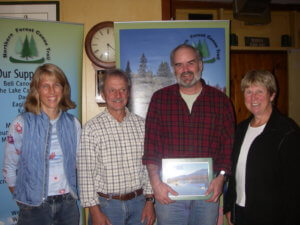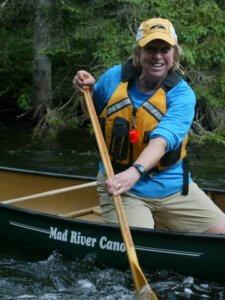As the Northern Forest Canoe Trail celebrates its 20th anniversary, we’re sharing stories that highlight the progress the trail and our organization have made over the last two decades. Earlier this year, we interviewed Kay Henry and Rob Center for part one and part two of a three-part series exploring NFCT’s past, present and future.
Part one explored the years leading up to the NFCT’s founding; part two looked at the early days of the organization. In this installment, Kay and Rob consider the progress made over the last two decades and envision the next 20 years.
Chris Morris: What does the NFCT mean to you, today?
Kay Henry: The Trail is a permanent asset for paddlers to discover the Northern Forest region of the Northeastern US — its rivers and lakes and associated ecology; its history from the Indigenous peoples through the Revolutionary War and birthplace of America to its current status; its economic and social infrastructure and its outdoor fun. As has been highlighted during this pandemic, Americans cherish the ability to spend time in the natural world and preserving the access to the rivers and lakes of the NFCT gives us places to adventure, increase our paddling skills, and just enjoy our outdoor surroundings. It also gives us glimpses of rural communities and the opportunity to learn more about special places. The unfettered access for all to water on which to recreate is key in an area of predominately private land holdings.

Rob Center: To think that Kay and I could actually run with a concept and convert it into an actual entity complete with a stewardship organization amazes me to this very day. We encountered plenty of skeptics along the way, but we were persistent in our belief that this could benefit so many. For the Northern Forest Canoe Trail to become recognized as a paddling destination of national and international significance is incredible. It’s been kind of fun to be wallpaper when conversations are taking place about places to paddle and the Northern Forest Canoe Trail is mentioned as a must-do destination. In the 90s on paddler bucket lists were only The Boundary Waters and the Allagash Wilderness Waterway; now water trails exist in almost every state.
What we originally saw as a need for greater paddling access across the Northern Forest which would benefit communities economically has now morphed especially over the past 10 months into a societal recognition that outdoor experiences such as paddling contributes greatly to quality of life. The NFCT has much to offer going forward.
Chris: What lasting impacts has the canoe trail made on your lives?
Kay: In addition to a feeling of pride in securing a resource for others who want to adventure and explore, I have learned a lot through this journey. From the decision making experience of a CEO of a private, for-profit company to the creation of a multi-state non-profit organization with a Board of Directors to govern and sustain its mission, creating the NFCT organization demanded a lot of new skills and very collaborative work. Bringing together diverse voices and skillsets from different parts of the region to work towards a common purpose was challenging and rewarding. Chairing this initial Board through the organization stages of structure creation, funding, community building (the effort that Rob led so effectively), and map creation was engaging and frankly, all encompassing.
I also learned a great deal about working in the political world during this time, working with the Congressional delegations of the four states as Federal seed monies enabled the NFCT’s creation. This effort and knowledge has sparked my continued interest in the outdoor world, working with the state of Maine to create a State Office of Outdoor Recreation to continue advocating for the economic growth potential and preservation of outdoor places to play. I am also working with new outdoor companies in the state on the Board of Maine Outdoor Brands.

Rob: With the help of others many things are possible. That has been my mantra for well over 50 years. This project would only have succeeded if the trail could be embraced locally and I’m forever humbled that others envisioned a similar outcome as did I and pitched in. We would be totally remiss if we didn’t give a big shout out to all of those many individuals, agencies, organizations, outdoor companies, and the National Park Service RTCA that were inspired to contribute in so many ways along this long journey. Without their help the Northern Forest Canoe Trail never would have been possible, and we thank, each and every one of you. And heartfelt thanks to the NFCT staff past and present for their passion and work.
Chris: Where do we go from here? Where do you envision the NFCT in five, 10, 20 years?
Kay: I hope that the organization continues be an engaging opportunity to introduce others to outdoor experiences. I hope it becomes a real teaching place for youth who have not had the same advantage of being outdoors and learning the outdoor skills that we have had. Although I am not personally involved with the NFCT’s direction now, I hope that the goals of creating something lasting for both paddlers who come to visit and beneficial for the people who live along its course will continue to be carried forward permanently.
Rob: I do worry about the perception that the NFCT is a done deal. Nothing is further from the truth. It is a living, breathing entity that needs to be nourished.
I would hope that very question — “Where do we go from here?” — be asked by the NFCT organization to the business, civic, and recreation leaders in the 45 communities across the Trail. Communication is essential given its geography. It is so important that they remain engaged and vested in the NFCT. Maintaining and growing those relationships are going to be vital for the Trail’s future.
Property owners, too! Communities were skeptical at the onset, but now through the years they have seen what the Trail means for their residents either as a place to paddle, use as an outdoor learning classroom, or as a contributor to the local economy. Pressure is only going to increase on maintaining the Trail’s infrastructure with the growing interest in paddling as a result of the pandemic.
The organization also needs to be supported financially by the greater paddling community and it encourages me greatly to learn from Karrie that 2020 has seen a record year in membership.
I see the recent development by the NFCT of staging the Adirondack Canoe Classic will further its’ role as an economic stimulator with communities from Old Forge to Saranac Lake and the regional tourism agencies. The 90-miler may well serve as a template to further NFCT events in Vermont, New Hampshire, and Maine.
I do hope I live to see the day when the demand for outdoor heritage tourism is such that Native American owned paddling services will stretch across their ancestral homelands which the NFCT flows through. Clients would likely come away with a far greater respect for the land, waters, and air learned from Indigenous peoples relationship with the landscape.